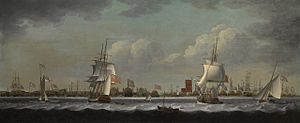HMS Kent (1798) facts for kids

HMS Kent (1798) image
|
|
Quick facts for kids History |
|
|---|---|
| Name | HMS Kent |
| Ordered | 30 April 1795 |
| Builder | John Perry and Company Blackwall Yard |
| Laid down | October 1795 |
| Launched | 17 January 1798 |
| Commissioned | 3 April 1798 at Woolwich Dockyard |
| In service |
|
| Honours and awards |
Naval General Service Medal with clasp "Egypt" |
| Fate | Broken up, 1881 |
| General characteristics 1798–1817 | |
| Class and type | Ajax-class ship of the line |
| Tons burthen | 1,96373⁄94 (bm) |
| Length |
|
| Beam | 49 ft 7.5 in (15.126 m) |
| Depth of hold | 21 ft 5 in (6.53 m) |
| Sail plan | Full-rigged ship |
| Complement | 690 |
| Armament |
|
| General characteristics 1820–1881 | |
| Class and type | Ajax-class ship of the line |
| Tons burthen | 2,00962⁄94 (bm) |
| Length |
|
| Beam | 50 ft 0 in (15.24 m) |
| Depth of hold | 21 ft 10 in (6.65 m) |
| Sail plan | Full-rigged ship |
| Armament |
|
HMS Kent was a large sailing warship called a 74-gun third-rate ship of the line. This means she was a powerful vessel with 74 cannons, designed to fight in the main battle line of a navy. She was part of the Royal Navy and was launched on January 17, 1798, at a place called Blackwall Yard.
Contents
The Ship's Early Life and Adventures
A Tricky Launch
When HMS Kent was launched on January 17, 1798, something unexpected happened. She was launched right after another large ship, an East Indiaman named Lord Duncan.
Kent followed almost the exact path that Lord Duncan had taken. Because of this, Kent's back end crashed into the front of Lord Duncan. Both ships were badly damaged. They both had to go back into the dockyard for repairs before they could sail properly.
Serving in Egypt
In 1801, HMS Kent was involved in an important military campaign in Egypt. On May 9, 1801, Kent, along with two other British ships, Hector and Cruelle, tried to catch a French warship called Heliopolis.
However, the French ship was too fast and managed to escape into the port of Alexandria. Even though they didn't catch the ship, Kent and her crew played a role in the Navy's campaign in Egypt, which lasted from March 8 to September 8, 1801. Because of their service, the officers and crew later received a special award. They were given the "Egypt" clasp for their Naval General Service Medal, which was approved in 1850.
The Attack on Palamós
On December 13, 1809, HMS Kent took part in a daring attack in Spain. About 350 sailors and 250 marines from Kent and two other large warships, Cambrian and Ajax, attacked a town called Palamós.
Smaller ships, Sparrowhawk and Minstrel, helped by covering the landing party. The British team managed to destroy six out of eight merchant ships. These ships were carrying important supplies for the French army in Barcelona. They also destroyed the ships that were guarding them. These guards included a small warship with 14 guns and 60 men, and two xebecs (a type of sailing ship) with three guns and 30 men each.
These enemy ships were hiding safely inside a protected harbor area called a mole. They were also guarded by 250 French soldiers and a battery of powerful cannons. Even though the attack was successful in destroying the enemy ships, the British withdrawal was difficult. The British lost 33 men who were killed, 89 who were wounded, and 86 who were taken prisoner. One sailor also used the chance to leave the navy.
The End of HMS Kent
After many years of service, HMS Kent was changed into a sheer hulk in 1856. A sheer hulk is a ship that has had its masts and rigging removed. It is then used as a floating crane to help build or repair other ships. Finally, in 1881, HMS Kent was broken up, which means she was taken apart.


